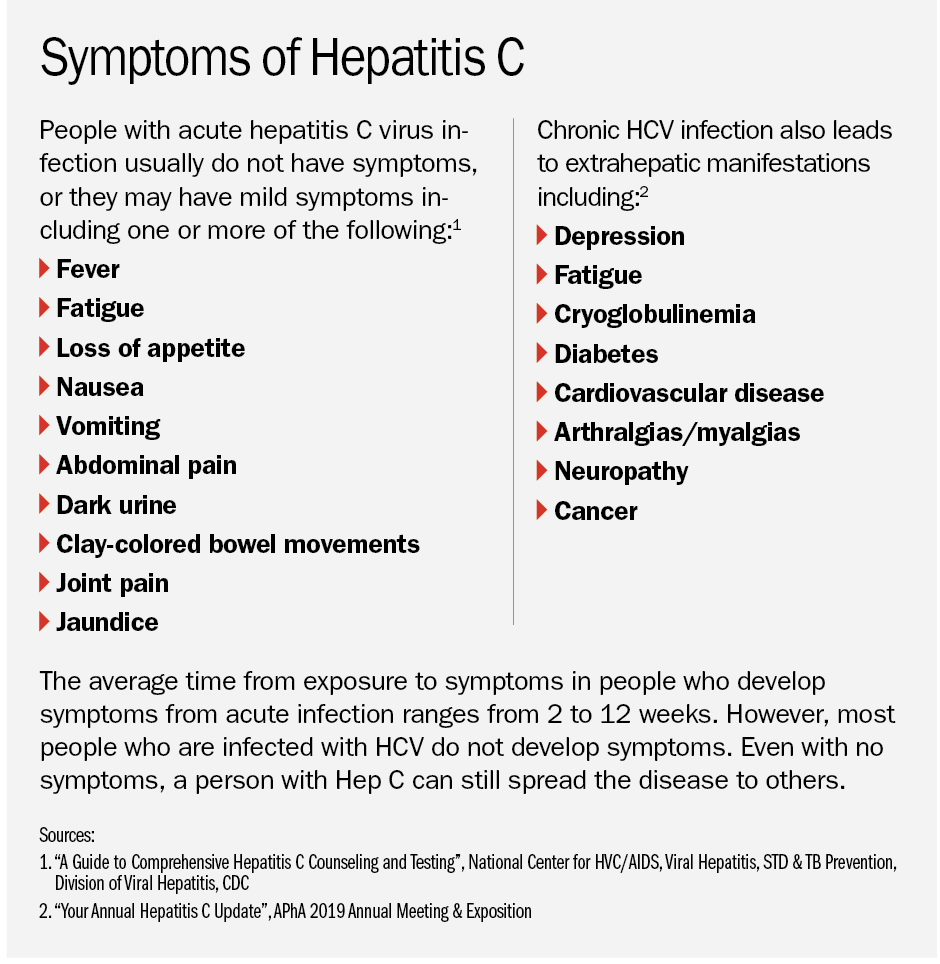Hepatitis C: Resurgence of a Silent Epidemic
3.5 million Americans estimated to be living with chronic HCV infection, but half may not know.

Symptoms of Hepatitis C

In the United States, much of the effort to identify the estimated 300 million people who are living with viral hepatitis, but who have not been diagnosed, is now focused on diagnosing and treating hepatitis C (HCV), which the CDC has called “a silent epidemic.”
The statistics are sobering: about 3.5 million Americans are believed to be living with chronic HCV infection, and it is estimated that at least half of them don’t know that they are infected. The number of acute hep C cases reported to the CDC more than tripled between 2010 and 2016.
Hep C is the most common chronic blood-borne infection in the United States. It is ten times more infectious than HIV, and is the leading cause of liver disease and liver cancer. More deaths are attributed to hep C than from all 60 other reported infectious diseases combined.
Trending: Discount Drug Cards Are Flourishing
The CDC says that 320,000 deaths can be prevented by testing and referring infected persons to care and treatment. Experts agree that community pharmacists can make a major contribution to this effort.
While there is no vaccine for HCV, there is reason for optimism because there are more new medications available to treat the disease than ever before. These medications are dramatically changing treatment regimens and providing new hope for eradicating the disease, but this will happen only if patients are identified, diagnosed, and treated.
The Recent History of Hep C
Prior to 1989, hepatitis C was the virus with no name. In the preceding decade, large numbers of patients apparently suffering from a viral disease had been identified, but tested negative for both hepatitis A and B. The disease became known as non-A non-B hepatitis until it was sensibly renamed hepatitis C
In 1990, a test was developed to identify patients infected with HCV, but that created a new treatment challenge. Typically mild in its early stages, hep C is often not diagnosed until it is advanced, taking as long as 20 years to get to that point. Consequently, up to 85% of HCV infections become chronic, with increased risk of severe liver disease, including cirrhosis and liver cancer, and death. Hep C, in combination with hep B, now accounts for 75% of all cases of liver disease worldwide.
“Hepatitis C is predominantly spread by blood contact, so people who have used intravenous drugs or received a blood transfusion before 1991 when hepatitis C testing became available for the blood supply, are the main group of people who get hepatitis C,” says Coleman Smith, MD, a transplant hepatologist at Medstar Georgetown Transplant Institute and member of the National Medical Advisory Committee of the American Liver Foundation.
Up until quite recently, hepatitis C occurred most frequently in people born between 1945 and 1965-the so-called baby boomers. Today, however, the opioid epidemic is changing the epidemiology of the disease in the United States
“There’s now a second peak of hepatitis C occurring in much younger people, and that’s theoretically quite problematic,” Smith continues. While many older hep C patients have been or are being treated, many of the younger patients are not so fortunate. Additionally, Smith notes that there are still many people who don’t have access to medical care, are unaware of hepatitis C, continue to use drugs, or are incarcerated or homeless who are at increased risk.
The Hep C Treatment Landscape
Up to 25% of people infected with hep C clear the virus from their bodies without treatment. The remainder will develop an acute infection that, left untreated, becomes chronic. The game changer for treating them has been the introduction of direct-acting antivirals (DAAs) that have replaced the traditional regimens of the past.
“With the new medications that have clearance in the high 90th percentile, and the pangenotypic medications that are coming out, there’s more of a focus to treat these people so they don’t progress into decompensation and severe liver disease,” says Julie Akers, PharmD, a clinical assistant professor in the Department of Pharmacotherapy at Washington State University College of Pharmacy and Pharmaceutical Sciences. “The difficulty with that in the clinician’s world is that they didn’t already have that focus to be looking for the risk factors for hep C,” which meant that patients were not being routinely screened.
Read More: How to Prevent the Top 4 Medication Errors
DAA medications are less toxic and offer treatment regimens of eight to 12 weeks, depending on the patient’s degree of liver function or genotype. They target specific steps in the HCV life cycle to stop the virus from self-replicating. There are four major categories of DAA: NS3/4A protease inhibitors (PIs), nucleoside and nucleotide NS5B polymerase inhibitors, NS5A inhibitors, and non-nucleoside NS5B polymerase inhibitors
Smith says DAAs have made identifying people who need treatment even more critical. “If you have someone who has hepatitis C who has access to medical care and insurance, or the wherewithal to pay for these still-expensive drugs, you have a 95% to 99% chance of curing them-and when I say ‘cure’, I mean completely eradicating hepatitis C,” he declares.
Continue reading on page 2...Point-of-Care Testing
Now that effective treatment is in place, the challenge remains to get screening and diagnostic services to the people who need it the most. One of the most logical places to start is the local community pharmacy and point-of-care (POC) testing.
According to John Beckner, RPh, senior director of strategic initiatives at NCPA, many customers are already being screened by pharmacists for illnesses like influenza, strep, diabetes, cholesterol, and HIV. Expanding POC testing to include hepatitis C is a logical next step.
“In a lot of cases, local pharmacists are the first line of defense. We have a lot of members in rural areas, and those members are really the face of neighborhood healthcare in the community that they serve,” says Beckner. “They have relationships with their patients, so they can certainly drill down and glean information from patients that might alert them to the fact that they’re a candidate to be screened for hep C.”
The initial antibody test involves a finger stick. It costs $50 to $75, and yields results in under an hour. As simple as that seems, Beckner acknowledges that there are some stumbling blocks, including reimbursement and individual state regulations governing POC testing. While most insurance companies do not reimburse for the test, the patient can pay out of pocket and submit for their own reimbursement.
“In today’s world of declining reimbursements, because pharmacies are being squeezed by the PBMs, this is one area that pharmacists can look at to ease the sting of declining prescription reimbursements,” he says.
Ongoing Role of Pharmacist
Once a patient has been diagnosed with hep C, the pharmacist can continue to play a role in his or her recovery. “Certainly we can have a role in helping choose the appropriate therapies, discussing adherence and adherence strategies, monitoring for toxicity, and the acquisition of the medications,” says Bernadette Jakeman, PharmD, and associate professor at the University of New Mexico College of Pharmacy.
She notes that hep C medications are often provided through specialty mail order pharmacies and require an extensive prior authorization process and high copays. “We oftentimes help with the prior authorization process as well as the patient assistance programs, which all the medications have. We can help make sure that patients can get and pay for their meds.”
Read More: Five Tips for Evaluating Clinical Studies
Affording the drugs can be a major hurdle for many patients. According to an analysis by the Blue Cross and Blue Shield Association, hep C antivirals costs increased by 19% between 2010 and 2016. Many patients find they cannot rely on coverage from their insurance companies. One study reveals that absolute denials of DAA regimens by insurers have remained high-averaging 35%-and increased over time, regardless of insurance type.
At least one pharmaceutical company has acted to help resolve the situation. In January, Gilead Sciences launched, through its subsidiary Asegua Therapeutics, authorized generic versions of its top-selling Harvoni (ledipasvir/sofosbuvir) and Epclusa (sofosbuvir/velpatasvir). The $24,000 list price for the most common course of therapy is significantly discounted from the branded versions, which can cost nearly $100,000 for a full course of treatment.
“We made this unusual decision because we believe that it is the fastest way to lower list prices for our HCV cures without significant disruption to the healthcare system and our business, as a bridge to longer term solutions aimed at reducing patients’ out-of-pocket medication costs, improving access for Medicaid patients and providing greater pricing transparency,” explained Gilead’s CEO John Milligan in a prepared statement.
Continue reading on page 3...The Final Word
One of the biggest challenges facing healthcare providers today is to spread the word that hep C treatment is far more effective, with fewer side effects and a shorter course than medications that were previously prescribed. Jakeman says it’s a message that’s important to impart to the general public as well to help get the disease under control.
“We have amazing treatments now for patients, so it’s a matter of us mobilizing to get people tested, into care, and treated,” she says. “A lot of people don’t have symptoms because they’re not cirrhotic, but there are a lot of non-liver type of symptoms that we’re seeing. There are definitely reasons to screen and treat early to prevent transmission and future cases.”

Driving Primary Vendor Compliance to Increase Pharmacy Purchasing Savings
April 17th 2025This white paper will examine some common—and costly—assumptions about vendor compliance. We’ll show that pharmacies must do more than meet the bare minimum to stay competitive. We’ll also discuss solutions that pharmacies can leverage to optimize compliance, drive savings from their primary vendor, unlock additional pharmacy savings and enhance purchasing.